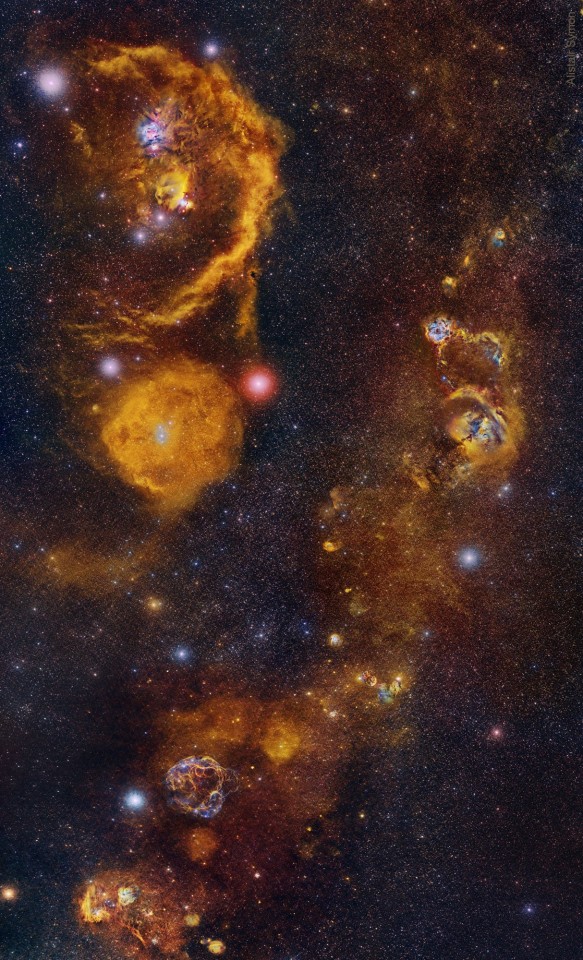Orion Over Argentine Mountains : Do You Recognize The Constellation Of Orion? It May Be Harder Than Usual

Orion over Argentine Mountains : Do you recognize the constellation of Orion? It may be harder than usual in today’s featured image because the camera has zoomed in on the center, and the exposure is long enough to enhance nebulas beyond what the unaided human eye can see. Still, once you become oriented, you can see Orion’s three belt stars lined up vertically near the image center, and even locate the familiar Orion Nebula on the upper left. Famous faint features that are also visible include the dark Horsehead Nebula indentation near the image center, and the dusty Flame Nebula just to its right. Part of the Orion-encircling Barnard’s Loop can also be found on the far right. The image combines multiple sky-tracking shots of the background in different colors with a single static foreground exposure taken at twilight – all captured with the same camera and from the same location. The picturesque scene was captured early last year from mountains in San Juan, Argentina. via NASA
More Posts from Chbnb and Others

From Auriga to Orion

Mongolia Gobi desert by Daniel Kordan




Craters on Moon:
1° From crater Theophilus (100km diameter) below to crater Langrenus above.
2° From bottom to top, dark titanium rich lava in the Sea of Fertility then the diamond shaped patch is the Marsh of Sleep. Small bright crater Proclus is thought to be a recent impact crater and has thrown out bright ejecta that is much lighter than the surrounding ancient weathered rock. Above is the rather hexagonal Mare Crisium.
3° From the Sinus Iridium top left through the Mare Imbrium with the Alpine Valley in the centre. (This original image is horizontal)
4° At the middle and bottom of this image, sunlight is shining on a mountain peak in the Alexander crater which lies beyond the day/night terminator.
Image credit: John Purvis

Mineral Moon by Astrophotographer Andrew McCarthy

“I will never get tired of night hiking and photographing our Galaxy! The Milky over the Adirondacks in NY [OC][1393x2048]”
By Reddit user: u/DanielJStein

Starburst Galaxy - Centaurus A (NGC 5128)

star cluster NGC 602 in the wing of the Small Magellanic Cloud

Further than the last footprint. By - Stanley Chen Xi

Heart of the Scorpion
-
 thingshavechangedbobby liked this · 2 years ago
thingshavechangedbobby liked this · 2 years ago -
 mtfunkzoo reblogged this · 2 years ago
mtfunkzoo reblogged this · 2 years ago -
 calmcrow liked this · 2 years ago
calmcrow liked this · 2 years ago -
 brandi927 reblogged this · 2 years ago
brandi927 reblogged this · 2 years ago -
 wolf-of-the-glade reblogged this · 2 years ago
wolf-of-the-glade reblogged this · 2 years ago -
 wolf-of-the-glade liked this · 2 years ago
wolf-of-the-glade liked this · 2 years ago -
 whatareyoureallyafraidof reblogged this · 2 years ago
whatareyoureallyafraidof reblogged this · 2 years ago -
 craftysciencetechnologyweasel liked this · 3 years ago
craftysciencetechnologyweasel liked this · 3 years ago -
 kittenmadnessandtea liked this · 3 years ago
kittenmadnessandtea liked this · 3 years ago -
 smilealreadydammit reblogged this · 3 years ago
smilealreadydammit reblogged this · 3 years ago -
 smilealreadydammit liked this · 3 years ago
smilealreadydammit liked this · 3 years ago -
 entopticalmeph liked this · 3 years ago
entopticalmeph liked this · 3 years ago -
 itsrrrrrrrr reblogged this · 3 years ago
itsrrrrrrrr reblogged this · 3 years ago -
 umbrellavulture reblogged this · 3 years ago
umbrellavulture reblogged this · 3 years ago -
 emjaydellyone liked this · 3 years ago
emjaydellyone liked this · 3 years ago -
 phuckinwicked reblogged this · 3 years ago
phuckinwicked reblogged this · 3 years ago -
 swords0827 liked this · 3 years ago
swords0827 liked this · 3 years ago -
 massivetyphoonflower liked this · 3 years ago
massivetyphoonflower liked this · 3 years ago -
 silverscribe87 liked this · 3 years ago
silverscribe87 liked this · 3 years ago -
 oshea52 liked this · 3 years ago
oshea52 liked this · 3 years ago -
 hellcatblues liked this · 3 years ago
hellcatblues liked this · 3 years ago -
 macgyvershe reblogged this · 3 years ago
macgyvershe reblogged this · 3 years ago -
 macgyvershe liked this · 3 years ago
macgyvershe liked this · 3 years ago -
 dvndyl reblogged this · 3 years ago
dvndyl reblogged this · 3 years ago -
 siremasterlawrence liked this · 3 years ago
siremasterlawrence liked this · 3 years ago -
 whatareyoureallyafraidof reblogged this · 3 years ago
whatareyoureallyafraidof reblogged this · 3 years ago -
 werewoofs liked this · 3 years ago
werewoofs liked this · 3 years ago -
 babbling-musings reblogged this · 3 years ago
babbling-musings reblogged this · 3 years ago -
 babbling-musings liked this · 3 years ago
babbling-musings liked this · 3 years ago -
 astrikonaou reblogged this · 3 years ago
astrikonaou reblogged this · 3 years ago -
 focusas reblogged this · 3 years ago
focusas reblogged this · 3 years ago -
 moon--train reblogged this · 3 years ago
moon--train reblogged this · 3 years ago -
 moon--train liked this · 3 years ago
moon--train liked this · 3 years ago -
 th4tg1rl1nth3corn3r reblogged this · 3 years ago
th4tg1rl1nth3corn3r reblogged this · 3 years ago -
 th4tg1rl1nth3corn3r liked this · 3 years ago
th4tg1rl1nth3corn3r liked this · 3 years ago -
 oshri liked this · 4 years ago
oshri liked this · 4 years ago -
 skyoftheuniverse reblogged this · 4 years ago
skyoftheuniverse reblogged this · 4 years ago -
 thatonetyguy liked this · 4 years ago
thatonetyguy liked this · 4 years ago
